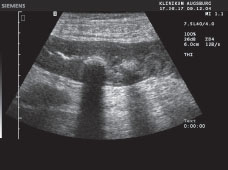| 1 | General Information Regarding Examination |
Introduction
In the thirty years since 1971 when total colonoscopy was first described (16), significant technical advancements have been made in terms of instrument handling and imaging capability. Nevertheless, colonoscopy remains a procedure requiring manual dexterity and concentration. The experienced examiner can now successfully reach the cecum in 98% of patients and in most cases can also reach the terminal ileum. Difficulties can be posed by a mobile and elongated sigmoid colon or transverse colon as well as by postoperative intestinal fixations and other adhesions. The entire examination generally takes around 30 minutes. Rapid advancement and inspection up to the cecum is desirable, considering the discomfort to the patient, though a careful examination of all colon segments when withdrawing the instrument is essential for a thorough examination.
Proper training and experience are necessary for correct diagnosis. The diagnostic spectrum of colonoscopy encompasses not only macroscopic assessment of the condition of the mucosa, but also the possibility of collecting a targeted biopsy sample and, more recently, the use of dye spraying techniques and magnification (see Chapter 3). The instrument channel of the flexible endoscope allows for therapeutic treatment during the examination to an extent not possible with any other imaging technique. Polyps, for example, can be removed at first diagnosis and bleeding can be stopped immediately.
Thus, colonoscopy is a technically demanding examination procedure with a high clinical yield combined with the capability of therapeutic intervention.
Indications and Contraindications
Indications. An assessment of the condition of the colonic mucosa is important where there are clinical indications of colitis, i.e., abdominal pain, diarrhea, malabsorption, perianal bleeding as a result of possible intestinal ischemia, inflammation, erosions and ulcers of various geneses, polyps and tumors, diverticula, or vascular malformations. Changes in bowel habits and an increasing tendency toward constipation are cause for performing an endoscopic search for a stricture in the intestinal lumen, e.g., due to neoplasia, diverticular myochosis (thickening of the circular muscle layer), or postinflammation stricture (Tab. 1.1).
Thickening of the intestinal wall can be viewed using imaging techniques such as sonography (Fig. 1.1), computed tomography, and magnetic resonance imaging. A resulting pathological finding is an indication for colonoscopy that often can provide greater accuracy and allows taking a biopsy.
Early detection and cancer prevention. Colonoscopy is becoming increasingly important for early detection and the prevention of colorectal carcinoma in the asymptomatic general population. According to the guidelines established by the German Federal Committee of Doctors and Health Insurers (Bundesausschuss der Ärzte und Krankenkassen) on 5 October 2002 and based on recommendations recommendations from the German Society of Digestive and Metabolic Diseases (Deutsche Gesellschaft für Verdauungs- und Stoffwechselkrankheiten, DGVS), colonoscopy should be performed as a part of cancer prevention every 10 years among those aged 55 and over in the general population (14). Given the polyp–carcinoma relationship according to Vogelstein and the results of large cohort studies in the USA and Europe, there is no doubt about the effectiveness of endoscopic polyp removal in carcinoma prevention (17). With regard to these indications as well, total colonoscopy has proved itself over sigmoidoscopy and Hemoccult testing (11) (Tab. 1.2). Considering the current capacity for colonoscopy it would take 10 years to screen the US population following these guidelines (15).
 | Constipation |
 | Diarrhea |
 | Abdominal pain |
 | Bleeding per rectum, unexplained anemia, weight loss |
 | Postpolypectomy surveillance |
 | Prevention/aftercare colorectal carcinoma |
 | Pathological thickening of the colon wall detected by other imaging procedures |
 | Primary tumor search with metastasizing malignancy, if resulting therapeutic measures |

Figure 1.1
Thickened intestinal wall in the sigmoid colon. Ultrasound examination of the left lower abdomen.
Contraindications. Only in a limited number of situations do the risks of colonoscopy outweigh the benefits of its diagnostic value. Contraindications include suspected intestinal perforation, imminent risk of perforation accompanying acute diverticulitis, deep ulcerous lesions, or vascular necroses (Tab. 1.3).
The overall condition of the patient should always be assessed to determine whether he could tolerate the physical strain of preparing for colonoscopy and endoscopy, including conscious sedation. Colonoscopy in patients with a recentmyocardial infarction is associated with a higher rate of minor cardiovascular complications compared with control patients. (3)
Population | Periodic colonoscopy for cancer prevention |
|---|---|
General population | Once every 10 years starting at age 55 |
Patients with colorectal polyp | Colonoscopy check-up once every three years, if no pathological findings at first examination, then further check-ups every five years |
Patients with hamartomatosis polyposis | No general surveillance recommendations |
Immediate family member with colorectal carcinoma or polyp at <60 years of age | Ten years earlier than the age of the index patient at which carcinoma/polyp occurred, repeat every 10 years |
Immediate family member with colorectal carcinoma or polyp at >60 years of age | First colonoscopy at age 40, repeat every 10 years |
Immediate family member with FAP (familial adenomatous polyposis) | Genetic carriers Stay updated, free articles. Join our Telegram channel
Full access? Get Clinical Tree
 Get Clinical Tree app for offline access
Get Clinical Tree app for offline access

|




